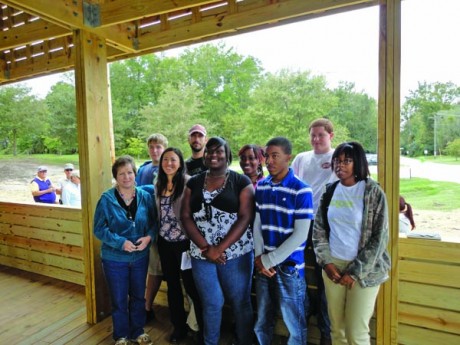Design. Build. Transform.
Magic, chaos, productivity and fun in Bertie County
By Michael E.C. GeryEmily Pilloton, who teaches an amazing design-and-build shop course at Bertie High School, further inspired a roomful of already-inspired eastern North Carolina teachers in November during the annual Bright Ideas Awards Dinner, hosted in Greenville by The Electric Cooperatives of Eastern North Carolina.
A young architect, industrial designer and author of the book "Design Revolution," Emily and her partner Matthew Miller also inspired 13 Bertie County high school juniors during the past year. They are students who live in a region considered the poorest in the state, where one in three children lives in poverty and less than 30 percent of third to eighth graders pass the state's standardized tests in math and English. Her 13 students endured what amounted to a year-long boot camp where they earned high school and college credits as they learned to think, create, measure, fail, succeed, work together and build things that made sense for themselves and their community. As Emily Pilloton says, the ultimate idea is "to use creativity to make something happen, to execute it to completion, and to transform the community."
Attracted to Bertie County in 2009 by former school superintendent Chip Zullinger, Emily transformed her non-profit Project H Design into Bertie High School's Studio H. With help from school staff and others, her students over time designed and built three "Learning Landscapes" playgrounds at local schools, three school computer labs, a weight room for the football team, far-out Cornhole boards, farther-out backyard chicken coops, and a brand new, from-the-ground-up farmers market pavilion known as the Windsor Super Market.
All of these projects required students to attend her class three hours per day, five days a week, and to work Studio H-paid summer jobs related to the projects. All also required students to learn relevant computer skills, design techniques, collaborative work methods, tool safety, model sketching, welding and carpentry, among other skills. To learn architectural cross-section and elevation diagrams, they cut in half a bell pepper and studied it. They conceived, designed and built everything within a learning environment that integrated their other academic work. Students were first afraid to learn a skill, then embraced it. They argued with one another about what to do next, and failed and failed until they succeeded. Emily described the experience as "magical, chaotic, productive and really fun."
 Emily Pilloton listed for the Bright Ideas grant winners four building blocks teachers can use to design courses that help students become "well-rounded." They are citizenship (a desire to work with and transform their community), creativity (no-holds-barred approaches to problem solving), capital (the means to acquire supplies and materials), and critical thinking (rethinking problems as long as it takes to get the solutions right).
Emily Pilloton listed for the Bright Ideas grant winners four building blocks teachers can use to design courses that help students become "well-rounded." They are citizenship (a desire to work with and transform their community), creativity (no-holds-barred approaches to problem solving), capital (the means to acquire supplies and materials), and critical thinking (rethinking problems as long as it takes to get the solutions right).
All of the Studio H projects were designed to fit into Bertie County, even the Cornhole boards, which students auctioned to help pay for the chicken coops, which they gave to neighboring families. After a couple rounds of community meetings to determine needs and preferences, the class learned building code provisions and designed the Windsor Super Market. The 2,000-square-foot building is meant to resuscitate a lapsed farmers market. At the grand opening last October, one of the students, Kerron, said of his Studio H experience, "It changed the way I see the world, and made me expect more of myself. I don't know any other 17-year old who can say they designed something like this. In 10 or 20 years I want to bring my kids here and tell them I built this."
The Studio H program continues in Bertie County in 2012. For more information and pictures of the projects, visit www.studio-h.org
-
Share this story:



